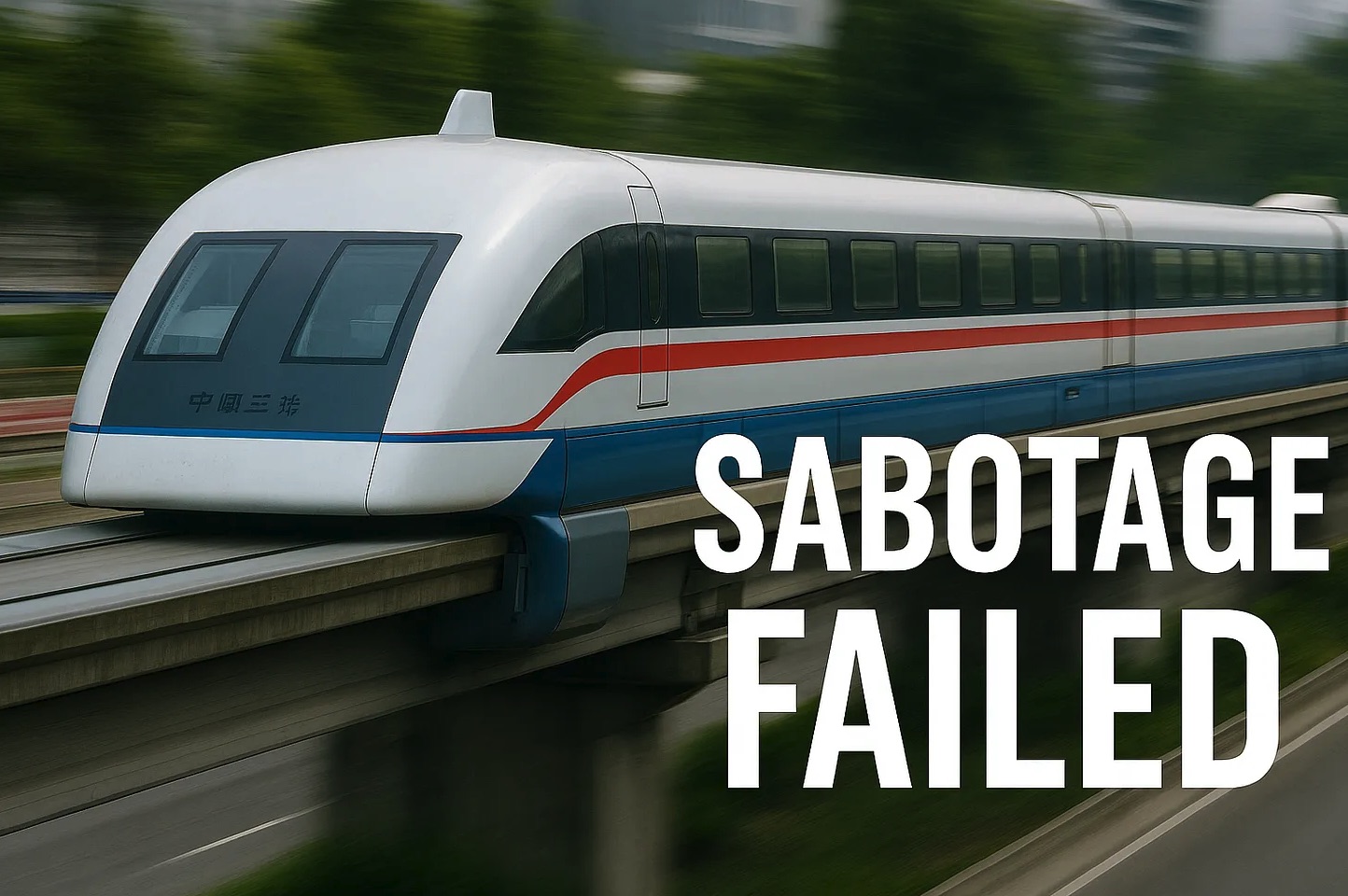A behind-the-scenes look at sabotage, supply blockades, and how China turned crisis into technological independence.
The Miracle on Rails — and the Hidden Sabotage Attempt
China’s railway network—including its world-class high-speed trains—is widely regarded as the best in the world.
But what most people don’t know is that two U.S. allies—some would more accurately say vassals—once tried to stop this from happening, almost derailing China’s “miracle on rails.”
This should surprise no one. Washington has long used every tool in its arsenal—economic warfare, propaganda, covert operations, and political subversion—to destabilize China, including recruiting proxy agents from Xinjiang to Tibet, Hong Kong, and Taiwan.

The author stands before a Maglev train in Shanghai. Maglev—short for magnetic levitation—is a cutting-edge high-speed rail system that uses powerful electromagnetic forces to lift and propel the train above its track, eliminating friction from wheels and rails. Modern Maglev trains can reach speeds of up to 600 km/h, making them among the fastest ground transport systems in the world.
Terror on the Tracks — Kunming and Urumqi
Uyghur separatists have carried out some of the deadliest terrorist attacks on Chinese soil:
- The 2014 Kunming train station massacre, where knife-wielding assailants killed 31 civilians and injured 143 others1.
- The May 22, 2014 Urumqi market bombing, when SUVs loaded with explosives rammed a crowded market, killing 43 people and injuring over 902.

In the summer of 2025, the author traveled by train through the Uyghur Autonomous Region of Xinjiang, now once again regarded as calm and secure. Seated beside him was a friendly Uyghur couple, with whom he took a commemorative photo. Like many of their compatriots, they spoke primarily their native language and had only limited proficiency in Mandarin. Unfortunately, Uyghur was not among the languages supported by the translation app on his mobile phone.
Many of these militants resurfaced in Syria, embedded within U.S.-backed factions bent on dismantling the country’s secular state. Flush with battlefield momentum, they stood in Damascus and pledged to carry their jihad back to China—proof that Washington’s proxies were not just destabilizing regimes, but incubating transnational terror.
From Century of Humiliation to Chip Wars
For nearly two millennia, China stood as an economic superpower—even serving as a key supplier to the Roman Empire—until the 19th century, when Western powers imposed the so-called “century of humiliation” through opium wars and a web of unequal treaties that left the nation impoverished and fractured.
That humiliation is a wound modern China is determined never to reopen.
When Washington tried to block China’s access to advanced microchips—the “new oil” of modern industry—Chinese scientists responded by building their own.
Huawei, the tech giant the U.S. tried to crush, now produces its own chips for phones, cars, and even port control systems—ready to challenge U.S. rivals globally.
2023 — The Bearing Blockade
In early 2023, China’s high-speed rail sector hit a crisis point. Germany and Japan—two top exporters of precision components—abruptly halted all exports of high-speed rail bearings to China3.
Framed as “economic security” policy, the move was in reality a calculated act of technological containment.
This wasn’t just a trade spat—it was the equivalent of grounding a nation’s air planes by cutting off jet engines.
The Hidden Heart of a High-Speed Train
Bearings—small steel rings, often no larger than a soup can—are what keep wheels, motors, and gears moving smoothly under immense heat, pressure, and vibration.

Picture: Zhongzhe high-speed railway bearing
At 350 km/h, a bearing failure could be catastrophic.
Despite mastering nearly every other aspect of train production, China still depended on imported high-performance bearings from German and Japanese firms.
Breaking the Chokehold
In Luoyang, engineers at LYC Bearing Corporation had quietly spent years perfecting metallurgy, micrometer precision, and durability curves.
In 2023, amid the blockade, they unveiled a fully domestically produced high-speed rail bearing for Fuxing bullet trains.

It wasn’t just equivalent—it was better. Rare-earth microalloying gave the steel unmatched strength, cleanliness, and fatigue resistance.
From Crisis to Independence
By early 2025, 17% of China’s high-speed rail bearings were made domestically. That figure is expected to surpass 90% by year’s end.
The blockade had backfired—forcing China into self-reliance and accelerating innovation.
A Palm-Sized Victory
Today, China’s bearings rival the world’s best. Some even end up in Europe, rebranded by Japanese companies.
This isn’t just about trains—it’s a lesson in technological sovereignty: when access is denied, you either collapse or create.
China chose to create. And in doing so, it turned a palm-sized ring of steel into a symbol of national strength.

